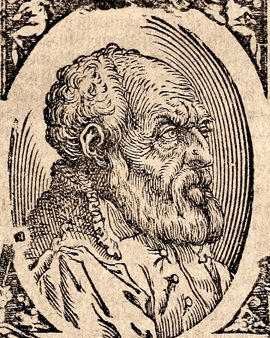Francesco Primaticcio, born on April 30, 1504 in the lively city of Bologna, knew early on that art was his calling. He moved in the circles of the sculptors and architects of his native city and appropriated their techniques and knowledge. But it was painting that captured his heart and led him to study under Giulio Romano, a disciple of Raphael. In the halls of the Palazzo del Te in Mantua, where he honed his skills, his art blossomed.
It was 1532 when his work caught the attention of France's King Francis I, who had a fondness for Italian culture and art. The king invited Primaticcio to his court in Fontainebleau, an invitation the young artist readily accepted. Together with Rosso, another Italian artist, he worked on the decoration of the royal palace and contributed significantly to the development of the Fontainebleau school, which played an important role in the spread of Mannerism in France.
After the death of Rosso in 1540, who at that time was in charge of the works at Fontainebleau, this role fell to Primaticcio. He had just made a trip to Rome to buy antiquities and make plaster casts of famous sculptures that would later be recast at Fontainebleau. Upon his return, he took up his new duties and his artistic activity at Fontainebleau reached its peak. Despite the change in royal preferences with the accession of Henry II in 1547, who preferred other artists and residences, Primaticcio remained active at Fontainebleau. He now found time to work for private patrons, creating works for the influential Guise family, among others.
After the death of Henry II in 1559, Primaticcio returned to the service of the royal court, this time at the invitation of the queen dowager Catherine de Medici. He assumed the role of overseer of the royal buildings and thus had responsibility for the design and maintenance of the royal palaces. Francesco Primaticcio died in Paris in 1570, but his artistic legacy lives on. As a co-founder of the Fontainebleau School and an important representative of Mannerism, he left an indelible mark on the world of art.
×





_the_chariots_of_t_-_(MeisterDrucke-1406603).jpg)
_the_chariots_of_t_-_(MeisterDrucke-1406603).jpg)
_-_(MeisterDrucke-1657838).jpg)
_-_(MeisterDrucke-1657838).jpg)
_-_(MeisterDrucke-1361661).jpg)
_-_(MeisterDrucke-1361661).jpg)
.jpg)
.jpg)
.jpg)
.jpg)
.jpg)
.jpg)
.jpg)
.jpg)
.jpg)
.jpg)
.jpg)
.jpg)
.jpg)
.jpg)
_-_(MeisterDrucke-1359213).jpg)
_-_(MeisterDrucke-1359213).jpg)
.jpg)
.jpg)
.jpg)
.jpg)
.jpg)
.jpg)
_-_(MeisterDrucke-1360219).jpg)
_-_(MeisterDrucke-1360219).jpg)
.jpg)
.jpg)
 Duchesse dEtamp - (MeisterDrucke-300444).jpg)
 Duchesse dEtamp - (MeisterDrucke-300444).jpg)
_Lady_of_Breze_Duchess_of_Valentinois_-_(MeisterDrucke-1002428).jpg)
_Lady_of_Breze_Duchess_of_Valentinois_-_(MeisterDrucke-1002428).jpg)
 (oil on slate) - (MeisterDrucke-58884).jpg)
 (oil on slate) - (MeisterDrucke-58884).jpg)
.jpg)
.jpg)
.jpg)
.jpg)
.jpg)
.jpg)
.jpg)
.jpg)
.jpg)
.jpg)
.jpg)
.jpg)
.jpg)
.jpg)
.jpg)
.jpg)
_-_(MeisterDrucke-1360953).jpg)
_-_(MeisterDrucke-1360953).jpg)
_-_De_Phaiaken_dragen_de_slapende_Odysseus_naar_Ithaka_-_(MeisterDrucke-1363796).jpg)
_-_De_Phaiaken_dragen_de_slapende_Odysseus_naar_Ithaka_-_(MeisterDrucke-1363796).jpg)
.jpg)
.jpg)
_-_(MeisterDrucke-295207).jpg)
_-_(MeisterDrucke-295207).jpg)
.jpg)
.jpg)
.jpg)
.jpg)
.jpg)
.jpg)
_-_Venus_met_twee_putti_-_(MeisterDrucke-1384526).jpg)
_-_Venus_met_twee_putti_-_(MeisterDrucke-1384526).jpg)
.jpg)
.jpg)
 1556 - (MeisterDrucke-219585).jpg)
 1556 - (MeisterDrucke-219585).jpg)
.jpg)
.jpg)
.jpg)
.jpg)
_-_(MeisterDrucke-318567).jpg)
_-_(MeisterDrucke-318567).jpg)
 - (MeisterDrucke-44967).jpg)
 - (MeisterDrucke-44967).jpg)
.jpg)
.jpg)
.jpg)
.jpg)
_-_(MeisterDrucke-1019962).jpg)
_-_(MeisterDrucke-1019962).jpg)
.jpg)
.jpg)
.jpg)
.jpg)
.jpg)
.jpg)
.jpg)
.jpg)
.jpg)
.jpg)
.jpg)
.jpg)
.jpg)
.jpg)
.jpg)
.jpg)
.jpg)
.jpg)
.jpg)
.jpg)
.jpg)
.jpg)
.jpg)
.jpg)
.jpg)
.jpg)
.jpg)
.jpg)
_-_Aankomst_van_Odysseus_en_metgezellen_bij_Circe_-_(MeisterDrucke-1388261).jpg)
_-_Aankomst_van_Odysseus_en_metgezellen_bij_Circe_-_(MeisterDrucke-1388261).jpg)
.jpg)
.jpg)
.jpg)
.jpg)
.jpg)
.jpg)
_-_(MeisterDrucke-1613394).jpg)
_-_(MeisterDrucke-1613394).jpg)
.jpg)
.jpg)






